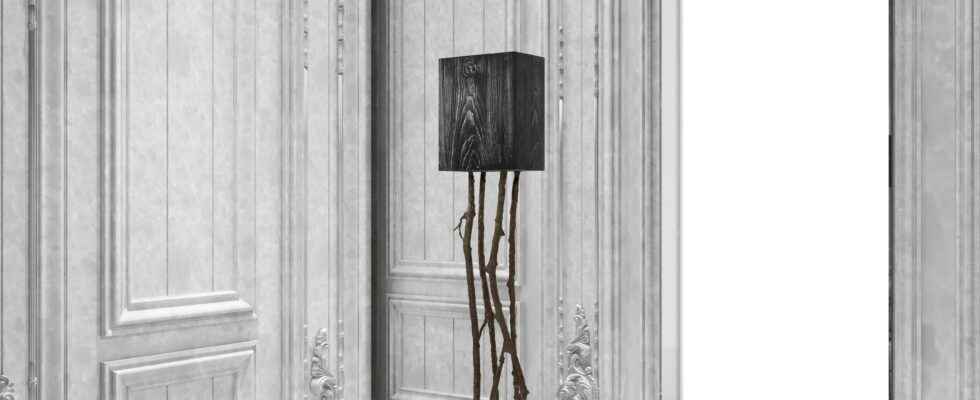A handful of visitors converge on the Gilles & Boissier boutique-apartment, on the first floor of a building on Avenue Montaigne, in Paris. The object of all desires? A cedar cabinet, placed on intriguing bronze legs as if from the imagination of the whimsical director Tim Burton. It is not so. The shape of these feet was created by an artificial intelligence. Artist and engineer Paul Mouginot designed software to sift through more than four million plants and generate different combinations. On the strength of these recommendations, he went to a forest in Burgundy to collect the nearest branches… before casting them in the alloy. The result is a unique piece, which delights Dorothée Boissier, founder of the premium architecture and decoration brand: “We need to be at the forefront, to understand and foresee what we will be offering our customers tomorrow” , she confides about this unexpected marriage.
Like the Gilles & Boissier agency, luxury houses are currently testing more than three new technologies on average (AI, 3D imaging, virtual reality, etc.), according to the “Luxe et technologie” study published in the received by the Bain & Company agency and the Comité Colbert. Among the challenges: the development of hyper-personalized creations or services. “Customers expect brands not only always more emotions, experiences, but also a fluidity between the physical and virtual worlds”, notes Mathilde Haemmerlé, co-author of the report. And more particularly, again, generations Y and Z (under 40 and 30), who will represent “70% of luxury buyers in 2025”, according to the expert.
From virtual fitting to remote touch
Among these services, virtual fitting in augmented reality is undoubtedly one of the most advanced. Henri Foucaud bears witness to this. The co-founder of the French start-up Hapticmedia connects from his smartphone to the Baume & Mercier shopping site and goes to a watch displayed at more than 3,000 euros. He clicks on the module developed by his company and the phone immediately switches to “camera” mode. By placing it in front of you, you can see the tocante on your wrist, which you can turn at your leisure to explore all the facets of the product. Louis Vuitton, Van Cleef & Arpels…: other watch and jewelry brands have been seduced by this concept. The module developed by the company would be used by “40 to 60%” of the customers of these houses.
The same type of service exists at Lancôme or Guerlain, for lipstick this time, whose shades can be scrolled through until you find the right one. Tomorrow, an AI will be able to enrich the experience and make an initial selection, adjusting to the customer’s wishes based on past purchases. These services may be able to be integrated into live shopping, which is also booming with the democratization of 5G and very high-end smartphones. In China, “the phenomenon represents 20% of the e-commerce business”, indicates Diaa Elyaacoubi, CEO of the Monnier Paris site, who is working to imagine forms of “storytelling” applied to the world of luxury accompanying this format.
Other practices are in their infancy, but seem to have a bright future. This is the case of remote touch via so-called “haptic” gloves. Which will allow tomorrow to discover in preview original materials, like the mushroom leather developed by Hermès. “Luxury also remains a story of quality products”, emphasizes Mathilde Haemmerlé. The Scent-Sation (sensation) helmet presented by Yves Saint Laurent last December aims to personalize the recommendations made to consumers by drawing up their “emotional profile”. “When you breathe in a chord, are you relaxed, focused, less stressed, energized, energized? Sensors in the headphones record how each scent note stimulates your neural activity by measuring the electrical impulses it triggers in areas specific to your brain”, announces the brand. If it is still impossible to take advantage of it in stores, some gray areas remain to be clarified, in particular those related to the question of the collection of this sensitive data by brands.
The metaverse offers more and more personalized experiences
Web3 technologies are attracting the attention of luxury houses just as much. With the creation of its own avatar, the possibility of choosing decorative elements and navigation as we see fit in the virtual space of a house, the metaverse offers increasingly advanced personalized experiences. NFTs open up new commercial horizons with the sale of “twin” virtual products to those purchased in stores. Moreover, no house has missed out on the success of Gucci, Prada or Tiffany, which have launched special, ultra-personalized collections in recent months in partnership with famous NFT creations – such as “CryptoPunks” – and gained back several tens of millions of dollars. A study by Morgan Stanley estimates the luxury market at 50 billion euros by 2030.
“The NFTs offer a cool, trendy aspect, in tune with the times. They help develop a sense of belonging to a community”, observes Laurent Buisine, creator of the luxury car club The Collection World, which has transformed its thousand entry badges into circulation in NFT tokens. The introduction of this technology certainly allows him to make his badge more rare, and to trace its “life” on the various platforms where it can be exchanged in the future and why not give it value. , but nothing more, or almost, than a “classic” badge. Same observation for the metaverse: it is too early for him to be able to render real services to the big houses. “It will be difficult to one day achieve the same level of service in the metaverse as in a physical space, confirms an interlocutor from a major French luxury brand. How, for example, can you serve a glass of champagne from a distance?”
